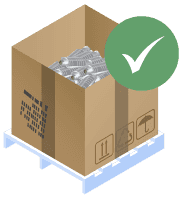Catalytic Converter Price
Serial Number vs. Price Lists to Identify Catalytic Converters Scrap Value

When it comes to recycling catalytic converters, one question remains front and center: “How much is my converter worth?”
The answer is much more complex than you think. With many moving pieces in the converter recycling and precious metal market, it’s difficult to put an exact price. And that’s because catalytic converters all live a unique life.
We created a comprehensive guide that breaks down everything that affects the scrap value of a catalytic converter, how serial numbers and price lists play a role, and why relying on either alone can leave money on the table.
What makes scrap catalytic converters worth so much?
At their core, catalytic converters hold three platinum group metals (PGMs): platinum, palladium, and rhodium. These metals are the driving force behind catalytic converter prices, and their volatility on the current market can shift the market value of scrap catalytic converters.
But even before discussing metal prices, several vehicle and converter-specific factors determine how much metal is recoverable once the unit enters the metal recycling stream.
Emission laws
There’s a reason why converters were not mandatory until the 1970s. Once regulators understood the impact of unfiltered exhaust system emissions (nitrogen oxides, carbon monoxide, and hydrocarbons), catalytic converters became the standard solution.
With a converter, your car transforms those toxic gases into less harmful pollutants, like carbon dioxide and water vapor.
But each decade and each state have different environmental requirements, and that means, a different amount of PGMs required in a converter.
For example, a converter that was built and put in place for a Californian car will have higher concentrations of platinum, palladium, and rhodium than one in Texas. That’s because California has tighter emission laws.
Age matters, too. An old catalytic converter from the 1980s or 90s usually contains far lower PGM loadings than a model produced after the 2000s, when emissions limits tightened and required more robust catalyst structures.
Manufacturing differences
Automotive manufacturers don't all follow identical tolerances. Even two converters with the same OEM part number can differ slightly in metal content based on production batch, supplier variation, or regulatory destination.
Because of these differences, two units with identical serial numbers may yield different amounts of platinum, palladium, or rhodium during the recycling process.
Material type
Vehicle type plays one of the largest roles in determining catalytic converter value. Let’s take a look at the differences.
OEM vs. Aftermarket
- OEM converters contain significantly higher precious metal loadings.
- Aftermarketcatalytic converters, often installed during repairs, are designed to meet minimum emissions requirements at a lower cost, meaning far lower PGM content. Recyclers should never expect comparable scrap value from aftermarket units.
OEM vs. aftermarket identification challenges
Distinguishing an OEM converter from an aftermarket converter can change valuation. Aftermarket converters, due to minimal PGM content, often have extremely low scrap value, yet they are commonly misidentified.
Key identification tips:
- OEM converters typically feature heat shields, unique shapes, and stamped serial numbers.
- Aftermarket converters often lack codes, use lighter construction, and may feature welded adapters.
Misidentifying an aftermarket unit as OEM can lead to significant financial loss, especially when paying based on a price list.
Diesel catalytic converters (DPFs)
Diesel engines require different systems:
- Diesel oxidation catalysts (DOCs) contain PGMs but often lower amounts than gasoline units.
- DPFs (Diesel Particulate Filters) operate differently by trapping soot. Some include precious metals; others do not.
Despite their size, DPF units don’t necessarily translate to high catalytic converter scrap prices unless they’re from heavy-duty engines with substantial PGM loads.
Why diesel units can be misleading
Many scrap yards assume larger means more. But diesel catalytic converters often have lower PGM content unless they come from large commercial diesel engines.
DPFs, despite being large, trap soot but may contain minimal precious metals unless combined with an oxidation catalyst.
This misunderstanding leads to:
- Overpaying on diesel units
- Incorrect sorting
Hybrid, truck, and foil converters
Hybrid vehicles run their engines less frequently, resulting in better-preserved PGM structures. Foil converters (metallic) differ from ceramic converters and may yield different values based on design.
Lifecycles
Every catalytic converter lives a unique life. And no two converters degrade at the same pace. Mileage, climate, maintenance, fuel quality, and engine condition all play critical roles. A converter can lose 5% to 20% of its precious metal value depending on this unique lifecycle.
How to accurately determine catalytic converter value?
If every unit is different, is there a reliable method to find accurate catalytic converter prices?
It depends on the approach you use, and how much risk you’re willing to tolerate.
Serial number catalogs
Serial number databases help recyclers identify approximate value, but they rely on a single analyzed sample from one converter. Because every unit lives a different life:
- Two converters with the same serial number might have drastically different PGM loadings.
- Rust, corrosion, and weathering often erase serial numbers on used catalytic converters, making identification unreliable.
- A database with incomplete codes will always lead to incomplete pricing.
Serial numbers can act as guidelines, but they cannot guarantee a price that reflects the true market value of your converters.
Price lists
Price lists work with average price calculations based on the refinings of many converters of the same type. While useful as a reference tool, averages hide the highest (and lowest) values your converters could yield.
If you’re buying:
- You may overpay for low-value units.
If you’re selling:
- You may undervalue high-yield units.
Price lists also shift constantly based on current price, market price, and metal prices for rhodium, palladium, and platinum. In a volatile market, especially the automotive recycling sector, averages can quickly become outdated.
Global metal supply & the non-ferrous market
Catalytic converter recycling falls under the broader category of non-ferrous scrap metal. Global mining output, geopolitical conditions, labor disputes, and environmental regulations directly affect the supply chain for precious metals, which in turn affects the market value of recycled converters.
For example:
- Rhodium is one of the rarest metals on Earth, and even small disruptions in South African mines (the world’s largest supplier) can create major spikes in market price.
- Palladium demand surged when automotive manufacturers shifted away from platinum in the early 2000s, impacting catalytic converter prices dramatically.
Understanding these economic factors helps you anticipate shifts in the current market and make more informed choices.
The role of theft trends in market awareness
A modern complication: widespread catalytic converter theft.
Because criminals target high-value converters, certain models (Toyota Prius, Honda Accord, Ford F-250, etc.) have inflated public awareness and misconceptions about average price and scrap value.
Theft publicity can distort expectations among sellers, creating a mismatch between perceived and actual value.
Why combining price lists and serial numbers still matters
Neither tool is perfect alone, but together they offer better visibility:
- Serial numbers help identify general category and expected loadings.
- Price lists help gauge average price trends and market fluctuations.
This combination empowers buyers and sellers to avoid guesswork and confidently navigate the automotive recycling, scrap yards, and scrap metal industries.
What is the most accurate way to determine the true value of your catalytic converters?
The most accurate way to determine the exact value of your scrap converters is to scientifically measure the platinum, palladium, and rhodium they contain.
Before we get into what that means, you need to be aware of the risks associated with the precious metal market, especially with uncertain market trends. And that means having access to information from both price lists and serial number catalogs.
Using a combination assures that you have all the information you need to make the right business decisions.
Working with a toll-refiner
Working with a toll-refiner gets you as close to the accurate precious metal value as possible. Most catalytic converter processors separate by material type and assay converter lots, which results in pricing that reflects an entire load of your converters and not by unit.
Toll-refiners, like PMR, will cut, crush, and grind your catalyst material until it’s a fine homogenous powder. That’s where they’ll take multiple samples to test in the lab. Through XRF and ICP devices, gold standard instruments in the industry, they’ll determine the exact amount of platinum, palladium, and rhodium contained in your converters.
That means you get paid for every ounce of precious metals in your material, not an ounce less.
It’s also important to work with a processor that’s transparent with their information and methods. This way, you’re empowered with your assay results to turn a profit and grow your operations.
Without a converter processor, there is no universal law to determine the exact worth of recycled catalytic converters. If you’re buying converters, it’s important to be agile with both serial number catalogs and price lists so you can make the best decisions.
Working only by price lists is accepting to work by estimates only and serial numbers don’t guarantee any price!
But having a converter process you trust gives you access to a combination of both serial number catalogs and price lists. That means you have all the information you need to make smart, profitable buying choices that work for your business.
Still relying on an idea of converter value? Start getting the right tools and information that give you real-time visibility into precious metal pricing and reliable converter returns. Visit our tool’s page or book a free consultation!

